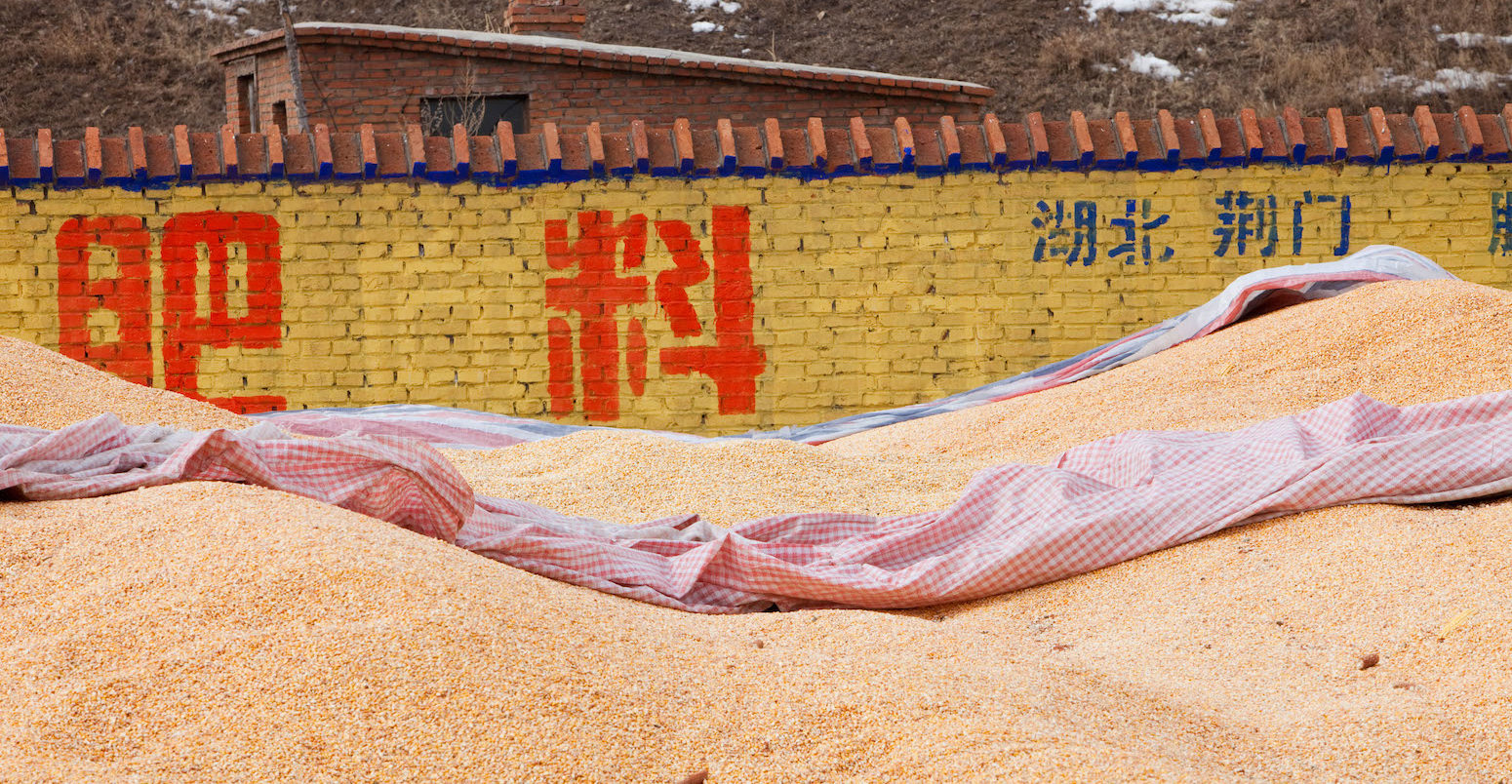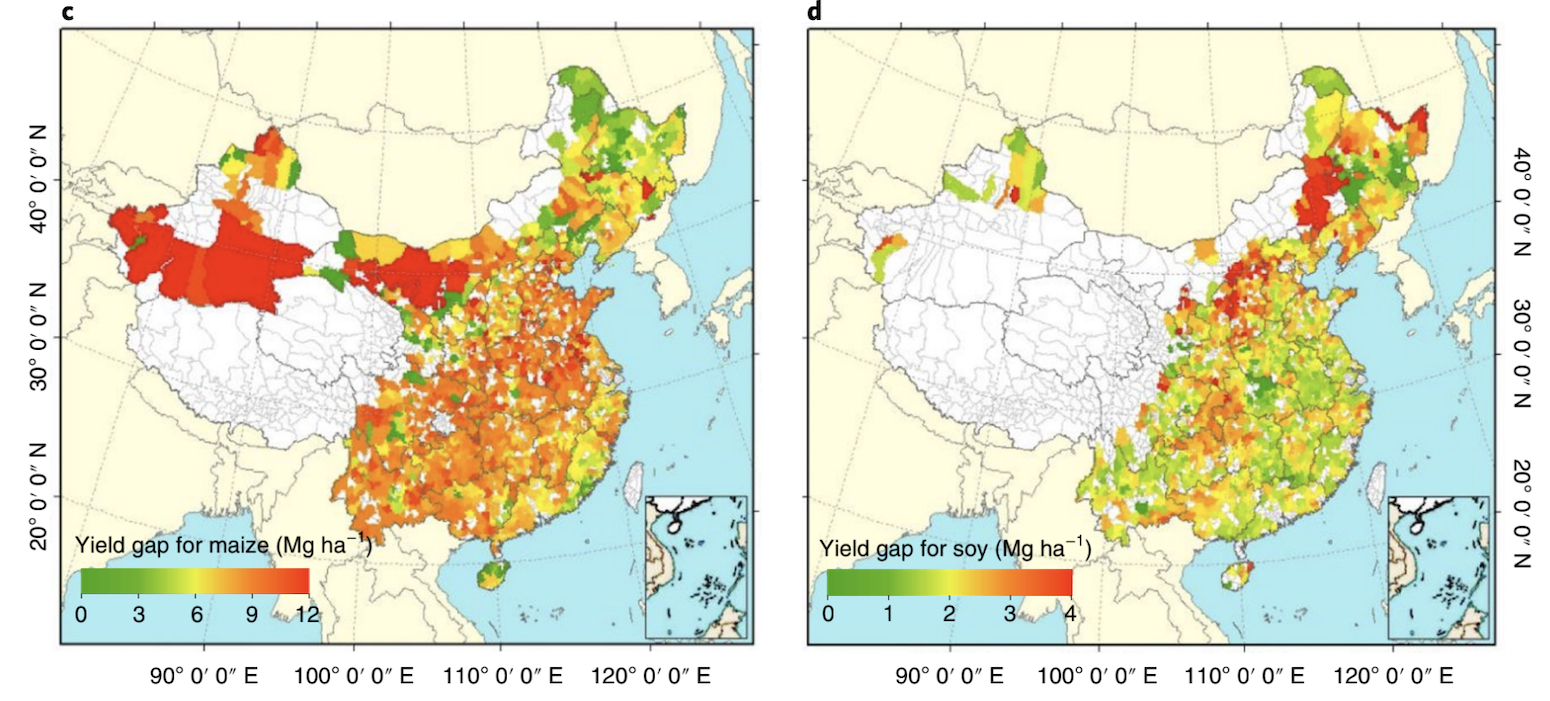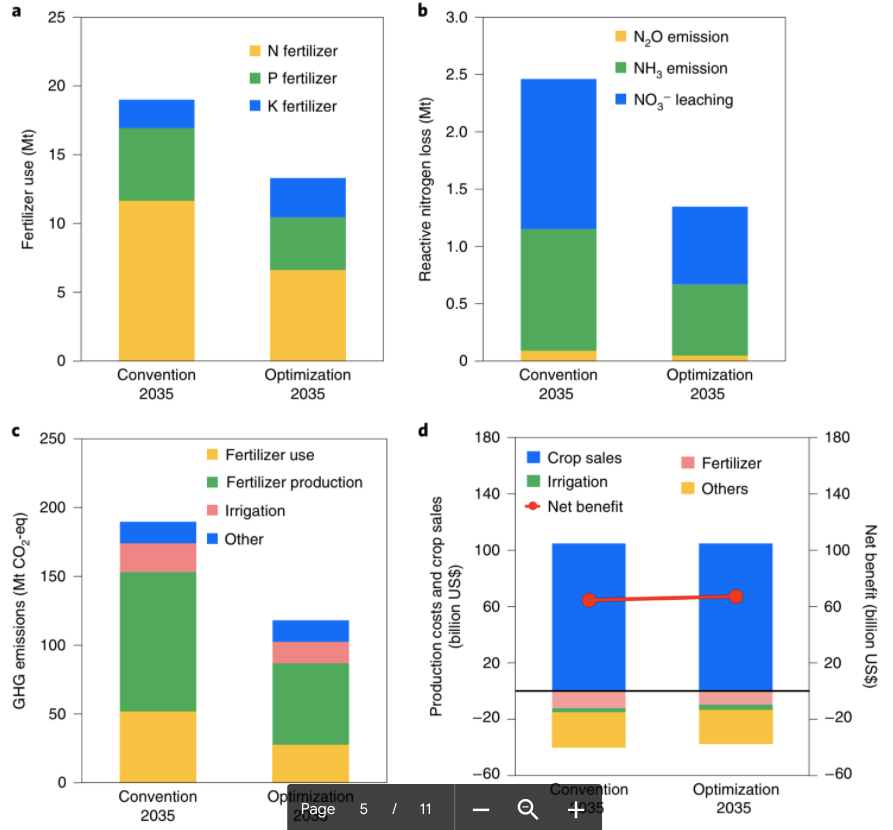
Sustainable production of soy and maize could ‘boost yields and cut emissions’ in China
Giuliana Viglione
06.14.21Giuliana Viglione
14.06.2021 | 4:00pmSwitching to more sustainable production of soy and maize could boost food security in the world’s most-populous country and simultaneously alleviate some of the environmental impacts of agriculture, new research shows.
The study, published in Nature Food, examines soy and maize production in China at the county level. It finds that converting some of the land from maize to soy and implementing a set of more sustainable farming practises would cut both greenhouse gas emissions and fertiliser use by 2035.
If the recommendations laid out in the study are followed, the researchers write, greenhouse gas emissions associated with the two crops would be reduced by 19% and yields improved by up to 40%.
One researcher not involved in the research calls the fertiliser-reducing practises “massive low-hanging fruit” for a more sustainable food system, adding that it’s a “win-win-win scenario”.
Mind the gap
Food security – the ability for a country to produce its own food – is a critical issue in China. It can help protect farmers from market swings and insulate a country’s food supply from geopolitical disputes.
For these reasons, “ensuring food security is China’s top priority”, Prof Zhenling Cui of China Agricultural University in Beijing, one of the authors of the new study, tells Carbon Brief. It is particularly important as the demand for maize and soy – which account for more than half of the cereal crops produced worldwide – have soared in China over the past two decades.
Since 2000, annual consumption of maize in the country has doubled, while the consumption of soy has increased four-fold, according to statistics kept by the UN Food and Agriculture Organization (FAO). This growing demand for soy and maize is being driven by an increasingly large appetite for animal-derived products, such as meat, eggs and dairy. But while China’s farmers have managed to keep pace with the demand for maize, they only produce about 10% of the soy needed domestically.
Imports fill that demand gap – in 2017, for example, China purchased about two-thirds of the soy being sold on the international market, according to the FAO. This mass-purchasing has impacts around the world, the authors note: the surging demand has “corresponded with hikes” in soy prices on the international market.
In addition to the impacts on global food markets, the ever-increasing demand for soy is contributing to deforestation in the Brazilian Amazon and Cerrado. One 2018 analysis, for example, found that about 10% of deforestation in the Cerrado was linked to clearing land for soy production. (Brazil produces nearly 40% of the world’s soy.)
In order to address the issue of food security and reduce China’s reliance on imports of foreign soy, Cui and his colleagues analysed agricultural data in the more than 1,800 counties that grow one or both staples. Using the Hybrid-Maize and SoySim crop models, the team determined the “yield gap” for each of the crops.
A yield gap is, essentially, the difference between how much of a certain crop a farmer, region or country is capable of producing and how much it actually does produce. The potential yield was calculated based on crop models that were fine-tuned for each county based on various agronomic parameters, such as planting date and the varieties of each crop planted.
The map below shows the calculated yield gap for maize (left panel) and soy (right panel) at the county level across China, with red and orange colours representing larger yield gaps.

Aggregated across all of the maize- or soy-producing counties in China, the yield gaps for both crops hover around 50%. By contrast, the maize yield gap in the US is around 20% and the yield gap for Brazilian soy is about 36% – suggesting there is “large room for improvement” for China, the authors write.
The authors also define an “attainable” yield, which is the average yield of the top 10% most productive farms in a given county. Averaged across the country, the researchers find that the attainable yield is just over 70% of the potential yield for each crop.
Based on the attainable yield in each county, the researchers propose “reallocating” cropland from maize to soy in a way that increases soy-growing capacity while still meeting the projected demand for maize in 2035. In total, they suggest that 11.7m hectares should be converted from maize-growing to soy-growing.
If this reallocation were implemented, the study finds, China would be able to produce 45% of its demand for soy, as compared to the 10% of domestic soy needs it currently meets – greatly reducing its reliance on foreign imports.
The study is “an improvement over its predecessors” that have aimed to address yield gaps, Prof Haishun Yang, an agronomist at the University of Nebraska–Lincoln who was not involved in the study, tells Carbon Brief. He adds:
“This is probably – at least in certain aspects – the first complete study of China to quantify attainable production levels for very important crops at the county level.”
But switching one crop for another may not be as straightforward as it sounds, Dr Xia Zhu-Barker, a soil biogeochemist at the University of California, Davis, tells Carbon Brief. For example, since maize can tolerate more acidic soils than soybeans can, land that is suitable for growing the former may not be a good fit for growing the latter.
Best practises
On top of the proposed land reallocation, the paper lays out the benefits of farmers changing from their current, conventional methods to a set of practises based on the concept of integrated soil–crop system management (ISSM).
ISSM best practises include managing nutrients and irrigation in a way that can simultaneously “increase the crop yield, improve the soil health and also reduce the negative environmental impact”, Zhu-Barker explains.
The “food system” – including land-use change, production, manufacture and transportation of food – is responsible for just over one-third of all human-caused greenhouse gas emissions. That fraction is even larger for certain greenhouse gases, such as nitrous oxide (N2O) – the food system contributes anywhere from half to three-quarters of all human-driven N2O emissions.
Much of the N2O emitted through agriculture is due to soil management and fertiliser use. But soy and other legumes grow symbiotically with bacteria that can take nitrogen from the air and convert it into the forms of nitrogen required for plant growth. So expanding soy planting allows farmers to decrease the application of synthetic fertilisers.
In fact, the study finds, under optimised growing conditions, the crops grown in 2035 could be produced with about the same amount of fertiliser as was used in 2017 – despite the much higher production. In addition, total losses of “reactive nitrogen” – the forms of nitrogen that can be readily used for biological processes – would decrease by 27% and greenhouse gas emissions would decrease by 19%.
The charts below show how the optimised production practises could reduce a) fertiliser use, b) reactive nitrogen loss, c) and greenhouse gas emissions, and d) production costs – all while seeing an overall financial benefit. The left-hand bar in each panel shows the scenario in 2035 assuming the same conventional practises are continued, while the right-hand bar shows the same if the proposed optimisations are carried out. In each panel, the different colours break down the total amount into specific elements of each reduction or change.

The study assumes that the effects of climate change – such as the impacts of extreme weather events, CO2 fertilisation or temperature increases – will not be keenly felt on the timescale the analysis covers. The authors write:
“Given the broad range of biophysical and climatic conditions across China, we assume that the yield-boosting and yield-inhibiting effects of climate change might cancel each other out to a certain extent and, thus, the net effects may be small.”
Since the analysis is only looking ahead until 2035, Yang says, this is a reasonable assumption to make. He adds:
“Within this timeframe, the trend of the climate change probably is smaller or less important than the real variation of the weather across years.”
A ‘win-win-win scenario’
The new work “provides important policy guidance”, Yang tells Carbon Brief. But, he adds, “the challenge to implement the recommendations or to achieve the goal feels underestimated”.
One reason is that, although the study was carried out at much smaller spatial scales than previous work, there can still be many variations – in topography, soil quality and resources – within a county. These sub-county-level differences may mean that some farms are not able to achieve the attainable yield set out in the paper, Yang says. But he hopes that future work with more refined models will be able to fine-tune the recommendations.
The study is “an incredibly important contribution”, Prof Pamela Matson, a biogeochemist and sustainability scientist at Stanford University, tells Carbon Brief. Matson – who has previously collaborated with several of the authors, but was not involved in the current work – says that addressing the implementation of the reforms is the next step:
“The next challenge now is to figure out how to get millions of farmers to employ sophisticated management approaches…but they recognise that and are working pretty hard on that, too. I also hope they move beyond just optimisation to more regenerative agricultural approaches.”
Implementing the reforms will be a challenge because the returns on soy are lower than those of maize, Dr Hannah Ritchie, the head of research at Our World in Data, tells Carbon Brief. Convincing farmers to make the switch is “unlikely” in the absence of governmental support and incentives, she says.
But, despite the challenges, the work makes a significant contribution to the literature and “moves the discussion forward on several intersecting issues”, Ritchie says. She adds:
“The standard narrative of agricultural development is that we can only produce more food by either increasing the amount of farmland we use, or by continually increasing agricultural inputs for higher yields. What these studies show is that it’s possible to achieve higher yields without ever-increasing fertiliser use, if we can improve its efficiency and adopt best practices.”
This is “massive low-hanging fruit for food security, but also for reducing nitrogen pollution and greenhouse gas emissions”, Ritchie says: “It’s a win-win-win scenario for farmers and the environment alike.”
Liu, Z. et al. (2021) Optimization of China’s maize and soy production can ensure feed sufficiency at lower nitrogen and carbon footprints, Nature Food, doi:10.1038/s43016-021-00300-1
-
Sustainable production of soy and maize could ‘boost yields and cut emissions’ in China
-
Optimise soy and maize production in China to ‘alleviate’ environmental impacts

